Alepidea genus
Alepidea F.Delaroche
Family: Apiaceae
Common names: alepidea, tinsel flower (Eng.); kalmoes (Afr.); ikhathazo (isiZulu); iqwili (isiXhosa); lesoko (South Sotho); inkatsankatsa (Swazi)
Introduction
Alepidea is one of only two African-endemic genera within the Saniculeae tribe of the Apiaceae, the other being its sister genus Arctopus. Southern Africa stands as the primary centre of diversity for this genus. Alepidea species are highly esteemed in traditional medicine for their rhizomes, particularly for their efficacy in treating respiratory and digestive ailments. However, the extensive harvesting of wild populations has led to over-exploitation, resulting in the classification of many species as threatened.

Description
Description
These perennial herbs form leaf rosettes at their bases and produce erect flowering stems, annually, from underground rhizomes, which store resin. The roots and rhizomes of these plants are highly resinous and emit a strong aroma when freshly cut. Initially white, the rhizomes quickly turn reddish-brown upon exposure. Some species possess substantial, thick rhizomes reaching up to 40 mm in diameter, whereas other species have smaller, fibrous rhizomes that do not exceed 10 mm in diameter and lack basal swelling.
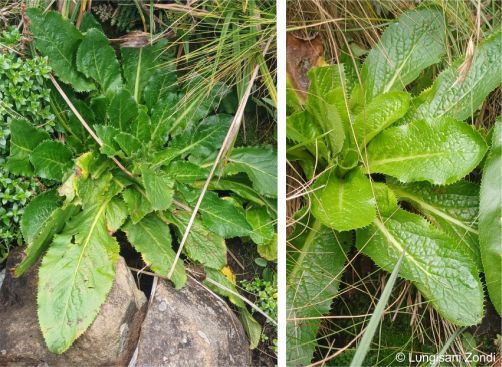
The leaves are simple, with some exhibiting smooth edges and others having coarse hairs or bristles along the margins. They are arranged in a whorled rosette at the base of the plant. A considerable variation in leaf shape and size is typically observed within species. Some species feature large leaves, conspicuously reaching up to 300 mm in length and 100 mm in width, while others have smaller leaves, generally measuring about 55 mm in length and 25 mm in width. These smaller leaves can be oval or narrower in shape. The leaf margins vary within the species; some have prominent crisped and lobed edges, while others exhibit regularly dentate margins, with each tooth extending into a fine hair.
The inflorescence is at the tip of a long scape from the roots, branched from below the middle, and has prominent fine hairs on the upper parts. The star-shaped flowerheads, consist of many small flowers surrounded by 5 large, petal-like bracts. These bracts are white to pale yellow on top, green below, and sometimes have fine hairs at the base. The bracts are triangular, with small alternating teeth.
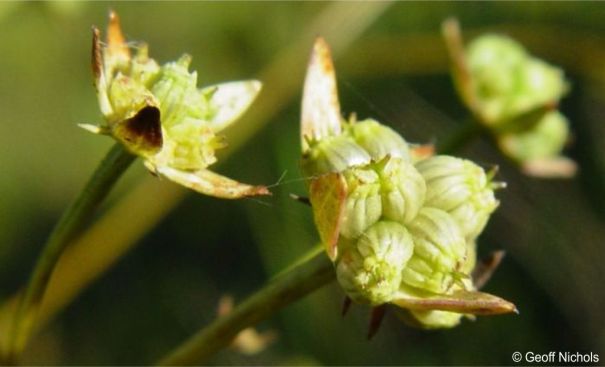
Fruits are small, egg-shaped schizocarps (dry fruits splitting into single seeded parts), smooth, with one surface flat and the opposite one curved, turning dark brown when ripe.
Conservation Status
Status
The relentless extraction of underground stems, known as rhizomes, of various species of Alepidea for trade in informal southern African medicine markets, has caused their wild populations to decline. This alarming trend has resulted in some species being placed on the Red List of South African Plants, signifying their threatened status.
Among the 28 Alepidea species, Alepidea attenuata finds itself precariously on the edge, classified as Near Threatened, while Alepidea macowani, Alepidea multisecta and Alepidea jenkinsii face a high risk of extinction in the Vulnerable category. The future appears perilous for Alepidea amatymbica, Alepidea cordifolia and Alepidea longeciliata, all classified as Endangered and thus facing a very high risk of extinction. Alepidea delicatula and Alepidea insculpta are classified as Rare, although not at risk of extinction, they have small populations that need to be monitored.
Distribution and habitat
Distribution description
The genus Alepidea, confined to the African continent, comprises approximately 28 species, primarily endemic to southern Africa. Only two species extend their range as far north as the highlands of Kenya and Ethiopia. Alepidea is primarily associated with summer rainfall patterns, with a significant concentration of species in the eastern region of South Africa, extending into Lesotho, Eswatini, Mozambique and Zimbabwe. In South Africa, over 80 percent of the genus is distributed across four provinces: Eastern Cape, KwaZulu-Natal, Free State, and Mpumalanga. A few species are dispersed throughout the country, with some occurrences in Limpopo, Gauteng, and one in the North West province. Notably, two species inhabit the Cape winter-rainfall region, both of which are endemic to the area, namely Alepidea capensis and Alepidea delicatula. The natural habitats of Alepidea species predominantly include grassland or forest margins, along streams or rocky outcrops. Given the varied distribution of these species, some are found at lower altitudes, while others occur at higher elevations.
The genus name Alepidea means ‘without a scale’, based on the Greek prefix a- meaning ‘without’ and the word lepis meaning ‘a scale’. According to Drude's 1898 classification of Apiaceae, Alepidea is placed in the subfamily Saniculoideae, along with the medicinal genera Eryngium and Sanicula, predominantly found in north-temperate regions. Apiaceae, commonly known as the carrot family, includes aromatic herbs with stems often having pith or hollow internodes, and flowers arranged in flat-topped inflorescences. This family has been pivotal in human nutrition, medicine and religion globally, yielding essential food plants like carrots and celery, as well as culinary herbs such as parsley, coriander and cumin. The family comprises approximately 446 genera and around 3 540 species distributed worldwide.
Alepidea species are characterized by having simple leaves with prominently ciliate or bristly margins, and attractive inflorescences adorned with conspicuous involucral bracts and small clustered flowers.
Ecology
Ecology
Alepidea species are pollinated by insects. The bright whitish-cream flowerheads carried on top of long stems, rise above the other species in the grassland and attract the attention of pollinating insects such as bees and butterflies, which assist with pollination. Alepidea species are an important component of the Grassland Biome. In winter, the plants become dormant, the above-ground part of the withers and is subjected to burning, together with other grassland species.
Uses
Use
The underground stems, known as rhizomes, of Alepidea amatymbica and Alepidea cordifolia, and others, are used in traditional medicine to treat the colds of winter and other common complaints and ailments that plague the chest. Among the Zulu people, Alepidea amatymbica roots serve as a multi-purpose treatment for respiratory ailments. Eaten raw or cooked, they target coughs, colds and influenza. Dosing varies by age, with children receiving a teaspoon and adults a tablespoonful. Additionally, root infusions are directly administered to children with similar symptoms. Alternative applications involve inhaling powdered roots or smoke from burning roots. Beyond the Zulu tradition, these versatile rhizomes hold medicinal value for the Sotho and Xhosa people. They are widely used as topical treatments for both stomach and respiratory issues. Furthermore, Alepidea roots find application in treating rheumatism, stopping wound bleeding (styptic), and relieving sore throats through chewing. In Zimbabwe, the rootstock assumes a broader role. It tackles diarrhoea, pains and headaches. Interestingly, it is also employed as a bee repellent and a protective charm.
Chemically, the rootstock is resinous, highly aromatic and has a turpentine-like flavour. Researchers have identified several terpenoid kaurene derivatives within both the roots and aerial parts of the plant. Animal studies suggest potential antihypertensive, antimicrobial, and diuretic effects. Specifically, Alepidea longifolia root decoctions remain a traditional Zulu treatment for coughs.
Growing Alepidea genus
Grow
Alepidea species are not yet extensively cultivated. In their natural habitat, most species are typically found among rocks or along streams in waterlogged soil. For optimal growth in cultivation, similar conditions should be replicated. These plants thrive in regions with summer rainfall, necessitating moderate watering during the spring and summer growing seasons. During the winter dormancy period, plants should be relocated to a cool, dry area with good air circulation, ensuring they are kept out of the rain. Watering should resume with the onset of warmer weather in spring.
Alepidea could serve effectively as mixed border plants and are well-suited for inclusion in grassland gardens, where they should be inter-planted with grasses to mimic their natural ecosystem. Furthermore, alepideas are ideal for container gardening and can create an aesthetically pleasing display when planted among decorative rocks.
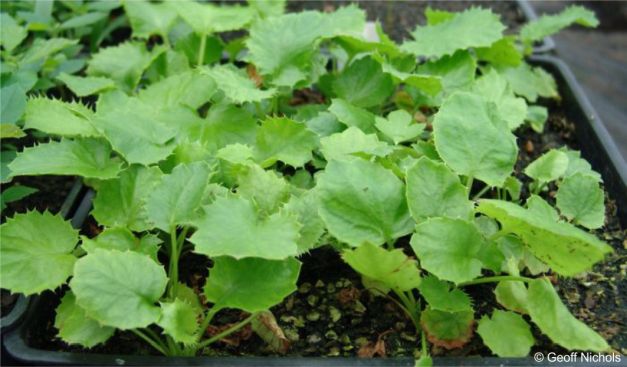
Members of this genus are usually propagated by seed or by division. Propagation from division is done by removing suckers that appear at the base of the plant. Suckers should be removed in spring and summer, and ensure that some root is taken with the new plant.
Propagation from fresh seed is the best method of producing new plants. Seeds of Alepidea stain one’s hands orange and have a strong, clean, antiseptic smell. Clean the seed, and sow in early spring or late summer, in well-drained, sandy loam soil, with the addition of some sifted kraal (cattle) manure or well-matured compost.
The seed can be sown on a firmly tamped surface and lightly covered with soil, approximately 3 mm deep. The seed trays should be kept in a bright, warm position out of direct sunlight and keep watering until germination takes place. Seed germinates within 14-20 days. Seedlings are very prone to damping off, therefore watering should only be done when necessary and seedlings should be monitored. Once potted into individual pots, the plants need to be grown on until the underground stem develops, after which they can be planted out.
Species
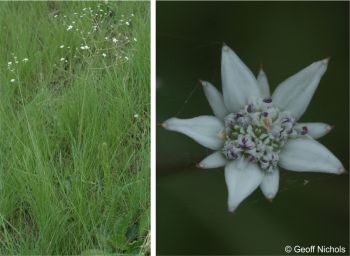
Alepidea amatymbica Eckl. & Zeyh.
A robust, erect perennial herb reaching up to 2 m tall, featuring a hollow, grooved, branched stem and aromatic rootstock. Its triangular, prominently toothed leaves form a basal rosette, with stem leaves lacking stalks. The flat-topped flowers, 20 mm wide, have 5 unequal bracts, white to pale yellow above and olive-green below, blooming from late summer to autumn.
This species is naturally found in the Amathole Mountains in Eastern Cape, extending along the east coast to KwaZulu-Natal and along the eastern border of Lesotho. It typically occurs on west- to south-facing slopes along drainage lines, in damp grassland near streams, or in rocky grassland at altitudes of 1 520–2 590 m.
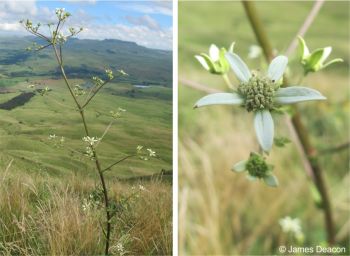
Alepidea cordifolia B.-E.van Wyk
A robust, erect perennial herb up to 2 m high with a hollow, grooved stem and aromatic roots from a rhizome. Its heart-shaped basal leaves form a rosette, while stem leaves lack stalks. The plant has a 1.8 m high inflorescence with star-shaped flowerheads and 5 unequal bracts. Flowers bloom in late summer to autumn.
This species is found along the north and north-eastern borders of Lesotho, extending into the eastern Free State, western KwaZulu-Natal, Eswatini, Mpumalanga, the eastern highlands of Zimbabwe, and the Chimanimani Mountains in Mozambique. It grows along forest margins, on west to north-facing mountain slopes, and on rivers or streams.
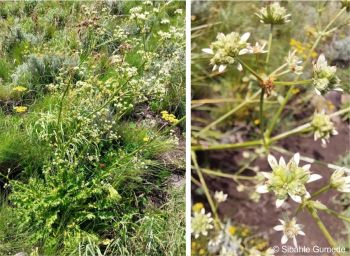
Alepidea macowanii Dummer
A robust, erect perennial herb reaching up to 2 m tall, with a hollow, grooved, branched stem and a thick, aromatic rootstock. The basal leaves are arranged in a loose rosette, simple, and range from 100 to 380 mm long and 20 to 135 mm wide. A. macowannii is distinguished by its crisped, lobed, multi-toothed leaf margins with inward-pointing setae, present in both basal leaves and peduncular bracts. Its equal or nearly equal involucral bracts differentiate it from A. amatymbica.
This species is found only in the Amathole mountain range, Eastern Cape, on steep, moist, south-facing rocky slopes.
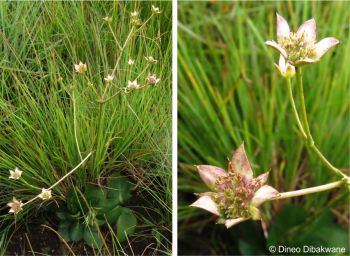
Alepidea natalensis J.M.Wood & M.S.Evans
A herbaceous perennial, reaching 200–600 mm in height, characterized by small, leathery leaves and slender flower stalks bearing small, white star-shaped flowers at the tips. The upper stems are bare. Basal leaves form a rosette narrowing to 10–20 mm stalks, dark green and leathery with entire or toothed margins and bristles. Flowerheads are ±15 mm wide with 5 equal triangular bracts, initially white and aging to pink on the margins.
Found in mountain grasslands among rocks in the Eastern Cape, KwaZulu-Natal, Free State, and Lesotho, flowering from late summer to autumn (December to April).
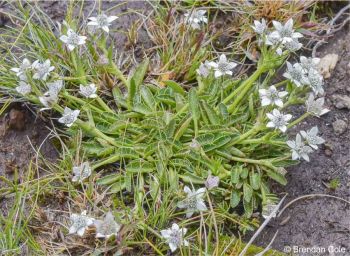
Alepidea pusilla Weim.
A dwarf perennial herb with short flowering stems, reaching 100-150 mm in height. It forms a basal rosette of thick leaves, 8-15 mm long and 4-7 mm wide, with bluntly toothed margins and no bristles. The white flowerheads feature 5 oval bracts with prominent net veins and appear in summer (January to February).
Endemic to the Eastern Mountain Region (EMR), including Lesotho's high mountains, it thrives in marshy turf at altitudes from 2 100 to 3 300 m.
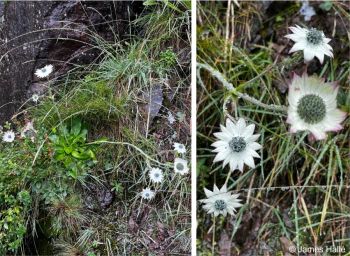
Alepidea thodei Dummer
A small perennial herb with flowering stems reaching 200-300 mm in height. Its mostly basal leaves have long marginal teeth that bend backward, with long stalks. The flowerheads are large and showy, measuring 30 mm in diameter, with 10-15 irregular white bracts and a dark blue-black center, blooming from late summer to autumn (January to April).
Endemic to the Eastern Mountain Region (EMR), which includes Lesotho's high mountains, it naturally grows in damp turf at the base of cliffs and on steep slopes, typically found at elevations between 2 400 and 3 000 m.
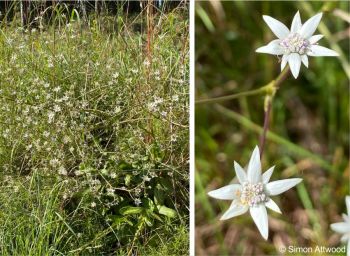
Alepidea peduncularis Steud. ex A.Rich.
A herbaceous, perennial plant producing strongly branched stems up to 1.2 m tall from a cluster of thick, fleshy, fibrous roots. The leaves are usually basal, up to 200 mm long in matured plants, hairless; margin toothed with a very prominent cilia at the apex of the teeth; petiole up to 100 mm long, sheathing at the base. Inflorescence branched, terminal; each branch with a terminal small dense head of minute florets subtended by a whorl of conspicuous white triangular bracts, the whole head resembling a single white-petaled flower. The leaves are edible, and the roots are used in medicine.
Found in grassland, open places in montane forest and woodland, rocky hillsides, often in seepage zones, from the Drakensberg region in southern Africa to Ethiopia, Sudan and DRC.

Alepidea woodii Oliv.
A slender perennial herb with flowering stems that grow to heights of 250-300 mm. Its papery leaves primarily form a basal rosette, measuring 70-100 mm long and 1.5-4 mm wide, with margins adorned by fine, evenly spaced teeth perpendicular to the edges. The flowerheads feature greenish-white bracts and bloom in summer, from January to February.
Endemic to KwaZulu-Natal (KZN), this species thrives along stream banks and on steep, damp grass slopes at elevations ranging from 1 800 to 2 400 m.
References
- Attwood, S. 2024-03. Observation of Alepidea peduncularis, Ehlanzeni, Mpumalanga. iNaturalist. Online. https://www.inaturalist.org/observations/202029102.
- Cannon, J.F.M. 1978. Umbelliferae. In: E Launert (ed.), Flora Zambesiaca 4: 555–621.
- Cole, B. 2021-01. Observation of Alepidea pusilla, Tiffindel, Eastern Cape. iNaturalist. Online. https://www.inaturalist.org/observations/68401476.
- De Castro A. & Van Wyk. B.-E. 1994. Diagnostic characters and geographic distribution of Alepidea species used in traditional medicine. South African Journal of Botany 60(6): 345-350.
- Deacon, J. 2021-02. Observation of Alepidea cordifolia, Kamberg, KZN. iNaturalist. Online. https://www.inaturalist.org/observations/70868047.
- Gumede, S.P. 2023-02. Observation of Alepidea macowanii, Amatholes region, Eastern Cape. iNaturalist. Online. https://www.inaturalist.org/observations/151749972.
- Hallé, J. 2023. Observation of Alepidea thodei, Drakensberg, KZN. iNaturalist. Online. https://www.inaturalist.org/observations/147823198.
- Hutchings, A., Scott, A.H., Lewis, G. & Cunningham, A.B. 1996. Zulu medicinal plants: an inventory. University of Natal Press, Pietermaritzburg.
- Hutchinson, S.-L., Tilney, P.M., Van Wyk, B.-E., & Magee, A.R. 2015. Towards a working taxonomic revision of the medicinally important genus Alepidea (Apiaceae). South African Journal of Botany 98:180. doi: 10.1016/j.sajb.2015.03.050.
- Hutchinson, S.L., Van Wyk, B.E. & Magee, A.R. 2022. Taxonomy and ethnobotanical overview of ikhathazo: The Alepidea amatymbica group (Saniculeae, Apioideae, Apiaceae). South African Journal of Botany 146:12-24.
- Maroyi, A. 2021. A review of medicinal uses, phytochemistry and pharmacological activities of Alepidea species. International Journal of Scientific & Technology Research 10(5): 382–391.
- Mulaudzi, R.B. 2009. Seed germination and medicinal properties of Alepidea species. M.Sc. Dissertation, University of KwaZulu-Natal, Pietermaritzburg.
- Nichols, G. 2005. Growing rare plants: a practical handbook on propagating the threatened plants of southern Africa. Southern African Botanical Diversity Network Report No. 36.
- Pooley, E. 2013. A field guide to wild flowers KwaZulu-Natal and the eastern region. Natal Flora Publications Trust, Durban.
- Raimondo, D., Von Staden, L., Foden, W., Victor, J.E., Helme, N.A., Turner, R.C., Kamundi, D.A. & Manyama, P.A. (eds) 2009. Red list of South African plants. Strelitzia 25. South African National Biodiversity Institute, Pretoria.
- Van Wyk, B.-E., de Castro, A., Tilney P.M., Winter P.J.D. & Magee. A.R. 2008. A new species of Alepidea (Apiaceae, subfam. Saniculoideae). South African Journal of Botany 74:740–745.
- Van Wyk, B.-E., Tilney, P.M. & Magee, A.R. 2013. African Apiaceae: a synopsis of the Apiaceae/Umbelliferae of sub-Saharan Africa and Madagascar. Briza Academic Books.
- Warren, P. 2016-02. Observation of Alepidea woodii, Umgungundlovu, KZN. iNaturalist. Online. https://www.inaturalist.org/observations/146196166.
- Yembaturova, E.Yu., Van Wyk, B.-E., Tilney, P.M. & Winter, P.J.D. 2010. The taxonomic significance of fruit morphology and anatomy in the genus Alepidea Delaroche (Apiaceae, Saniculoideae). Plant Diversity and Evolution 128(3):369–385.
Credits
Lungisani Zondi, Walter Sisulu National Botanical Garden
and Nompumelelo Nkosi, Pretoria National Botanical Garden
July 2024
Acknowledgments: the authors thank Geoff Nichols, Dineo Dibakwane, James Deacon, Sibahle Gumede, Simon Attwood, Brendan Cole, James Hallé and Peter Warren for the images.
Plant Attributes:
Plant Type:
SA Distribution:
Soil type:
Flowering season:
PH:
Flower colour:
Aspect:
Gardening skill:
Special Features:
Horticultural zones






Rate this article
Article well written and informative
Rate this plant
Is this an interesting plant?
Login to add your Comment
Back to topNot registered yet? Click here to register.